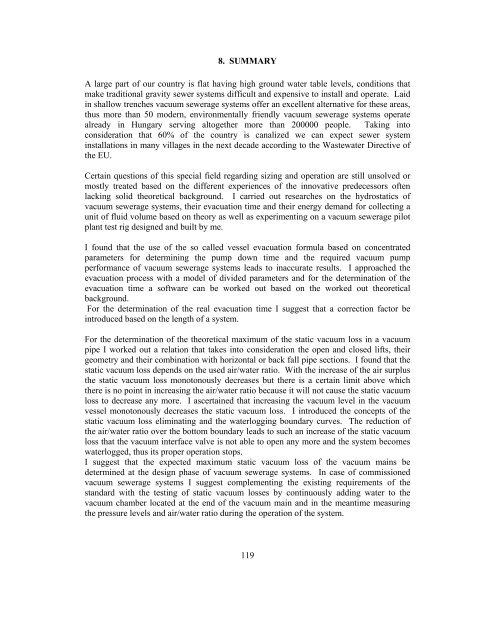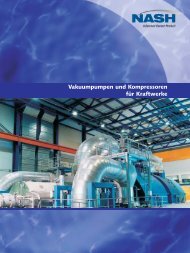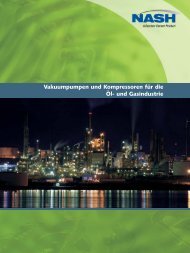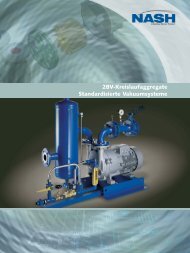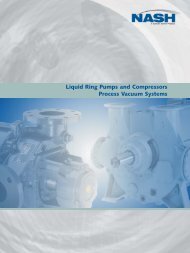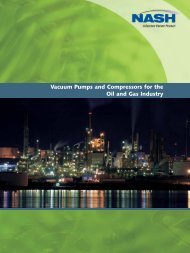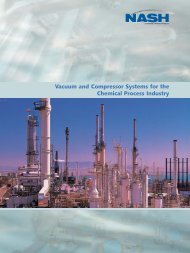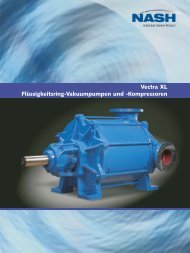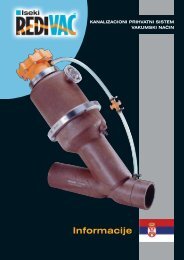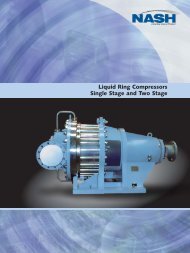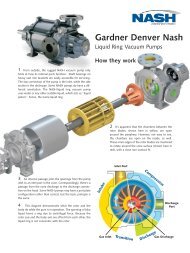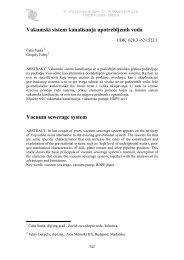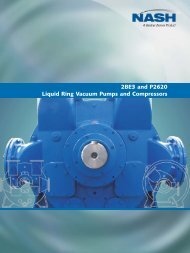értekezés - Szent István Egyetem
értekezés - Szent István Egyetem
értekezés - Szent István Egyetem
You also want an ePaper? Increase the reach of your titles
YUMPU automatically turns print PDFs into web optimized ePapers that Google loves.
8. SUMMARY<br />
A large part of our country is flat having high ground water table levels, conditions that<br />
make traditional gravity sewer systems difficult and expensive to install and operate. Laid<br />
in shallow trenches vacuum sewerage systems offer an excellent alternative for these areas,<br />
thus more than 50 modern, environmentally friendly vacuum sewerage systems operate<br />
already in Hungary serving altogether more than 200000 people. Taking into<br />
consideration that 60% of the country is canalized we can expect sewer system<br />
installations in many villages in the next decade according to the Wastewater Directive of<br />
the EU.<br />
Certain questions of this special field regarding sizing and operation are still unsolved or<br />
mostly treated based on the different experiences of the innovative predecessors often<br />
lacking solid theoretical background. I carried out researches on the hydrostatics of<br />
vacuum sewerage systems, their evacuation time and their energy demand for collecting a<br />
unit of fluid volume based on theory as well as experimenting on a vacuum sewerage pilot<br />
plant test rig designed and built by me.<br />
I found that the use of the so called vessel evacuation formula based on concentrated<br />
parameters for determining the pump down time and the required vacuum pump<br />
performance of vacuum sewerage systems leads to inaccurate results. I approached the<br />
evacuation process with a model of divided parameters and for the determination of the<br />
evacuation time a software can be worked out based on the worked out theoretical<br />
background.<br />
For the determination of the real evacuation time I suggest that a correction factor be<br />
introduced based on the length of a system.<br />
For the determination of the theoretical maximum of the static vacuum loss in a vacuum<br />
pipe I worked out a relation that takes into consideration the open and closed lifts, their<br />
geometry and their combination with horizontal or back fall pipe sections. I found that the<br />
static vacuum loss depends on the used air/water ratio. With the increase of the air surplus<br />
the static vacuum loss monotonously decreases but there is a certain limit above which<br />
there is no point in increasing the air/water ratio because it will not cause the static vacuum<br />
loss to decrease any more. I ascertained that increasing the vacuum level in the vacuum<br />
vessel monotonously decreases the static vacuum loss. I introduced the concepts of the<br />
static vacuum loss eliminating and the waterlogging boundary curves. The reduction of<br />
the air/water ratio over the bottom boundary leads to such an increase of the static vacuum<br />
loss that the vacuum interface valve is not able to open any more and the system becomes<br />
waterlogged, thus its proper operation stops.<br />
I suggest that the expected maximum static vacuum loss of the vacuum mains be<br />
determined at the design phase of vacuum sewerage systems. In case of commissioned<br />
vacuum sewerage systems I suggest complementing the existing requirements of the<br />
standard with the testing of static vacuum losses by continuously adding water to the<br />
vacuum chamber located at the end of the vacuum main and in the meantime measuring<br />
the pressure levels and air/water ratio during the operation of the system.<br />
119


